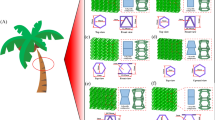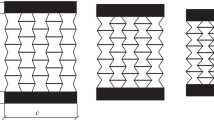Abstract
Kirigami arts have provided a more promising method for building multiscale structures, which can shape two-dimensional (2D) sheets into three-dimensional (3D) configurations by cutting and folding. Here, we first carried out a theoretical analysis of the mechanical properties of 2D honeycomb lattice structures and experimental verification combined with finite element (FE) simulation. Furthermore, a series of thick-walled 3D kirigami-inspired honeycomb (TW3KH) structures with different mechanical properties were designed and fabricated on the exploration and optimization of geometric parameters of 2D honeycomb structures. The investigations of folding feasibility, self-expansion, and self-folding performance experimentally showed that our designed four-dimensional (4D) printing structure had good programmability and shape memory capability and a large volume change ratio during shape change. Meanwhile, research on its compression deformation behavior found that the TW3KH structures can recover load-bearing capacity very well when the angle is positive. Therefore, these TW3KH structures have great advantages in space-saving smart load-bearing equipment.
Graphic abstract










Similar content being viewed by others
References
Wang ZG (2019) Recent advances in novel metallic honeycomb structure. Compos Part B Eng 166:731–741. https://doi.org/10.1016/j.compositesb.2019.02.011
Morales MM, Ramos MJG, Vazquez PP et al (2020) Distribution of chemical residues in the beehive compartments and their transfer to the honeybee brood. Sci Total Environ 710:136288. https://doi.org/10.1016/j.scitotenv.2019.136288
Qi C, Jiang F, Yang S (2021) Advanced honeycomb designs for improving mechanical properties: a review. Compos Part B Eng 227:109393. https://doi.org/10.1016/j.compositesb.2021.109393
Zhang Q, Liu H (2020) On the dynamic response of porous functionally graded microbeam under moving load. Int J Eng Sci 153:103317. https://doi.org/10.1016/j.ijengsci.2020.103317
Zhang JJ, Lu GX, You Z (2020) Large deformation and energy absorption of additively manufactured auxetic materials and structures: a review. Compos Part B Eng 201:108340. https://doi.org/10.1016/j.compositesb.2020.108340
Zhao W, Yue CB, Liu LW et al (2023) Mechanical behavior analyses of 4D printed metamaterials structures. Compos Struct 304:116360. https://doi.org/10.1016/j.compstruct.2022.116360
Gao JY, You Z (2022) Origami-inspired Miura-ori honeycombs with a self-locking property. Thin-Walled Struct 171:108806. https://doi.org/10.1016/j.tws.2021.108806
Wang QS, Li ZH, Zhang Y et al (2020) Ultra-low density architectured metamaterial with superior mechanical properties and energy absorption capability. Compos Part B Eng 202:108379. https://doi.org/10.1016/j.compositesb.2020.108379
Bates SRG, Farrow IR, Trask RS (2019) Compressive behaviour of 3D printed thermoplastic polyurethane honeycombs with graded densities. Mater Des 162:130–142. https://doi.org/10.1016/j.matdes.2018.11.019
Bayle O, Lorenzoni L, Blancquaert T et al (2016) Exomars entry descent and landing demonstrator mission and design overview. ExoMars EDM Overv Pap NASA
Zhang YW, Yan LL, Zhang WB et al (2019) Metallic tube-reinforced aluminum honeycombs: compressive and bending performances. Compos Part B Eng 171:192–203. https://doi.org/10.1016/j.compositesb.2019.04.044
Zhao W, Li N, Liu LW et al (2022) Origami derived self-assembly stents fabricated via 4D printing. Compos Struct 293:115669. https://doi.org/10.1016/j.compstruct.2022.115669
Bai JB, Chen D, Xiong JJ et al (2019) Folding analysis for thin-walled deployable composite boom. Acta Astronaut 159:622–636. https://doi.org/10.1016/j.actaastro.2019.02.014
Zhao W, Huang ZP, Liu LW et al (2022) Bionic design and performance research of tracheal stent based on shape memory polycaprolactone. Compos Sci Technol 229:109671. https://doi.org/10.1016/j.compscitech.2022.109671
Xiao R, Feng XB, Fan R et al (2020) 3D printing of titanium-coated gradient composite lattices for lightweight mandibular prosthesis. Compos Part B Eng 193:108057. https://doi.org/10.1016/j.compositesb.2020.108057
Zhao W, Huang ZP, Liu LW et al (2021) Porous bone tissue scaffold concept based on shape memory PLA/Fe3O4. Compos Sci Technol 205:108563. https://doi.org/10.1016/j.compscitech.2020.108563
Zhao W, Zhu J, Liu LW et al (2021) Analysis of small-scale topology and macroscale mechanical properties of shape memory chiral-lattice metamaterials. Compos Struct 262:113569. https://doi.org/10.1016/j.compstruct.2021.113569
Zhao W, Zhang FH, Leng JS et al (2019) Personalized 4D printing of bioinspired tracheal scaffold concept based on magnetic stimulated shape memory composites. Compos Sci Technol 184:107866. https://doi.org/10.1016/j.compscitech.2019.107866
Zhao W, Liu LW, Zhang FH et al (2019) Shape memory polymers and their composites in biomedical applications. Mater Sci Eng C 97:864–883. https://doi.org/10.1016/j.msec.2018.12.054
Yue CB, Li M, Liu YT et al (2021) Three-dimensional printing of cellulose nanofibers reinforced PHB/PCL/Fe3O4 magneto-responsive shape memory polymer composites with excellent mechanical properties. Addit Manuf 46:102146. https://doi.org/10.1016/j.addma.2021.102146
Zhao W, Liu LW, Lan X et al (2023) Thermomechanical constitutive models of shape memory polymers and their composites. Appl Mech Rev 75(2):020802. https://doi.org/10.1115/1.4056131
Van Manen T, Janbaz S, Ganjian M et al (2020) Kirigami-enabled self-folding origami. Mater Today 32:59–67. https://doi.org/10.1016/j.mattod.2019.08.001
Castle T, Sussman DM, Tanis M et al (2016) Additive lattice kirigami. Sci Adv 2(9):e16012. https://doi.org/10.1126/sciadv.1601258
Ning X, Wang XJ, Zhang Y et al (2018) Assembly of advanced materials into 3D functional structures by methods inspired by origami and kirigami: a review. Adv Mater Interfaces 5(13):1800284. https://doi.org/10.1002/admi.201800284
Callens SJP, Zadpoor AA (2018) From flat sheets to curved geometries: origami and kirigami approaches. Mater Today 21(3):241–264. https://doi.org/10.1016/j.mattod.2017.10.004
Zhai ZR, Wu LL, Jiang HQ (2021) Mechanical metamaterials based on origami and kirigami. Appl Phys Rev 8(4):41319. https://doi.org/10.1063/5.0051088
Ma JY, Dai HP, Chai SB et al (2021) Energy absorption of sandwich structures with a kirigami-inspired pyramid foldcore under quasi-static compression and shear. Mater Des 206:109808. https://doi.org/10.1016/j.matdes.2021.109808
Zhang X, Ma JY, Li MY et al (2022) Kirigami-based metastructures with programmable multistability. Proc Natl Acad Sci USA 119(11):e2117649119. https://doi.org/10.1073/pnas.2117649119
Le DH, Xu Y, Tentzeris MM et al (2020) Transformation from 2D meta-pixel to 3D meta-pixel using auxetic kirigami for programmable multifunctional electromagnetic response. Extrem Mech Lett 36:100670. https://doi.org/10.1016/j.eml.2020.100670
Gruber P, Häuplik S, Imhof B et al (2007) Deployable structures for a human lunar base. Acta Astronaut 61:484–495. https://doi.org/10.1016/j.actaastro.2007.01.055
Thesiya DA, Srinivas AR, Shukla P (2015) A novel lateral deployment mechanism for segmented mirror/solar panel of space telescope. J Astron Instrum 4:1550006. https://doi.org/10.1142/S2251171715500063
Sareh S, Rossiter J (2012) Kirigami artificial muscles with complex biologically inspired morphologies. Smart Mater Struct 22(1):14004. https://doi.org/10.1088/0964-1726/22/1/014004
Sun J, Scarpa F, Liu YJ et al (2015) Morphing thickness in airfoils using pneumatic flexible tubes and kirigami honeycomb. J Intell Mater Syst Struct 27(6):755–763. https://doi.org/10.1177/1045389X15580656
Zhang YH, Yan Z, Nan KW et al (2015) A mechanically driven form of kirigami as a route to 3D mesostructures in micro/nanomembranes. Proc Natl Acad Sci USA 112(38):11757–11764. https://doi.org/10.1073/pnas.1515602112
Tao R, Ji LT, Li Y et al (2020) 4D printed origami metamaterials with tunable compression twist behavior and stress-strain curves. Compos Part B Eng 201:108344. https://doi.org/10.1016/j.compositesb.2020.108344
Liu Y, Zhang W, Zhang FH et al (2018) Shape memory behavior and recovery force of 4D printed laminated Miura-origami structures subjected to compressive loading. Compos Part B Eng 153:233–242. https://doi.org/10.1016/j.compositesb.2018.07.053
Xin XZ, Liu LW, Liu YJ et al (2020) Origami-inspired self-deployment 4D printed honeycomb sandwich structure with large shape transformation. Smart Mater Struct 29(6):65015. https://doi.org/10.1088/1361-665x/ab85a4
Song C, Zou BH, Cui ZM et al (2021) Thermomechanically triggered reversible multi-transformability of a single material system by energy swapping and shape memory effects. Adv Funct Mater 31(32):2101395. https://doi.org/10.1002/adfm.202101395
Zhao W, Liu LW, Leng JS et al (2019) Thermo-mechanical behavior prediction of particulate reinforced shape memory polymer composite. Compos Part B Eng 179:107455. https://doi.org/10.1016/j.compositesb.2019.107455
Xin XZ, Liu LW, Liu YJ et al (2020) 4D printing auxetic metamaterials with tunable, programmable, and reconfigurable mechanical properties. Adv Funct Mater 30(43):2004226. https://doi.org/10.1002/adfm.202004226
Acknowledgements
This work was supported by the National Natural Science Foundation of China (Nos. 12072094 and 12172106).
Author information
Authors and Affiliations
Contributions
CBY conceived the idea, designed the experiments, carried out the data analysis, and wrote the first draft of the manuscript. WZ contributed to the guidance of the theoretical calculations and idea improvement. LWL contributed to supervision. FFL contributed to language modification. YJL and JSL had scientific discussions and improved the manuscript. All authors reviewed and commented on the manuscript.
Corresponding authors
Ethics declarations
Conflict of interest
The authors declare that they have no conflict of interest.
Ethical approval
This article does not contain any studies with human or animal subjects performed by any of the authors.
Additional information
Chengbin Yue and Wei Zhao have contributed equally to this work.
Supplementary Information
Below is the link to the electronic supplementary material.
Rights and permissions
Springer Nature or its licensor (e.g. a society or other partner) holds exclusive rights to this article under a publishing agreement with the author(s) or other rightsholder(s); author self-archiving of the accepted manuscript version of this article is solely governed by the terms of such publishing agreement and applicable law.
About this article
Cite this article
Yue, C., Zhao, W., Li, F. et al. Shape recovery properties and load-carrying capacity of a 4D printed thick-walled kirigami-inspired honeycomb structure. Bio-des. Manuf. 6, 189–203 (2023). https://doi.org/10.1007/s42242-022-00230-2
Received:
Accepted:
Published:
Issue Date:
DOI: https://doi.org/10.1007/s42242-022-00230-2




